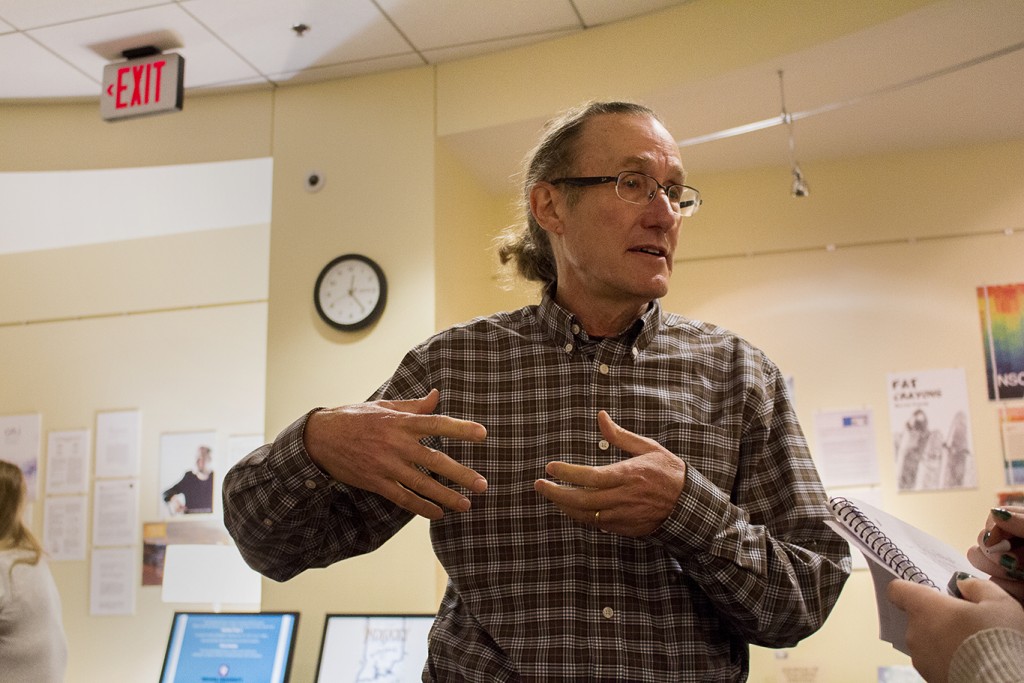
Kyle Forinash, professor and coordinator of physics, discusses an app series he co-created called “Mobile Science.”
By Kristin Kennedy
A physics student strapped himself in a roller coaster seat, and the ride began. As the roller coaster train inched up, the student launched an app on his cell phone to collect data as the ride accelerated. The app collected data during the ride, and once the student got off, he graphed the data on his phone.
An app series called “Mobile Science” makes this scenario, as well as several others, possible.
Kyle Forinash, professor and coordinator of physics, and Raymond Wisman, associate professor emeritus of computer science, have designed 10 apps in the series. Forinash said the apps can collect accelerometer data, magnetometer data and other data that can be useful for any person interested in seeing physics at work.
“You’ve got this computer in your pocket, so you should be able to do a lot of things with it,” Forinash said.
Forinash said scientists and students in labs normally have to use equipment to gather data, and he realized that apps could gather several types of data important to introductory physics students.
The apps enable students to experience physics concepts in real settings, including cars and amusement parks, Forinash said.
“It extends the laboratory outside the classroom,” he said.
However, Forinash said the apps are not just useful for physics students: Anyone can benefit from using the apps.
“This is just another way for people to look at an app and say, ‘I’m not in a classroom, but I can take some measurements and I can check that out,’” Forinash said.
Forinash said the first app in the “Mobile Science” series was “Acceleration,” which measures the acceleration of objects. “Acceleration” was first available on Nokia phones in 2008, and it’s now available on iOS devices.
On average, each finished app in the series took about two months to develop, Forinash said.
“Ray did most of the programming, but we would sit down and he would say, ‘Well, first, here’s an idea of what we’d like in the app,’ and then he would say, ‘What do you want? What do you want it to look like?’” Forinash said. “So we would talk over what kinds of experiments that we could do with it. Because he’s not a physicist, and he doesn’t know exactly what it might be useful for, so I could describe that and he could do the programming to make it happen.”
Forinash said he and Wisman had to overcome initial challenges in their app development process.
“Cell phones aren’t really designed to do this kind of work,” Forinash said. “So we have to be tricky.”
Forinash said they figured out that some of the apps can send and receive signals through the headset port in cell phones or tablets.
Forinash said some of the “Mobile Science” apps function to collect data from other apps, which he and Wisman did not develop, to make the data available in a spreadsheet or for download to a computer via email.
“We found that there are some great apps that collect data from internal sensors built into the phone – magnetic field, acceleration, sound, etc. – but only display the data on the screen,” Forinash said. “To do a science experiment you have to be able to record the data and further analyze it.”
Forinash and Wisman developed their most recent apps in spring 2014.
“HarmonicMotion” and “Accolyze” combine two free apps to collect and analyze accelerometer data, and “MagneticField” combines two free apps to collect and analyze magnetometer data, useful for studying the magnetic fields. The apps enable data to be transformed into a spreadsheet after it’s collected, and users can make graphs on the spreadsheets on their phones using the data on their cell phones.
Forinash said all of the “Mobile Science” apps are free. Besides the “Acceleration” app, the apps are available for Android devices.
Forinash said he and Wisman prefer Android because the apps are also available in developing countries, such as Argentina, and Android devices are typically cheaper than iOS devices in those countries. In summer 2014, Forinash and Wisman gave a workshop to about 30 Argentinian teachers who were interested in the apps.
Forinash said he and Wisman are working on a “Mobile Science” app that will measure voltage. He said he plans to discuss the app during the American Association of Physics Teachers conference in January.
Forinash and Wisman have provided information about the “Mobile Science” apps, as well as some videos for some of the apps, on their Wiki Spaces page. The Google Play store has information about each app, and it enables users to download them.


